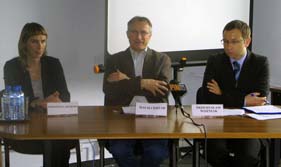Positive surprises for Polish economy?

The economy did not lose much traction in the 1Q2008 despite our previous expectations that the statistical-base effects should significantly dampen GDP growth, taken year on year. Expansion was driven by domestic demand. Our estimates point to a continuation of strong business fixed investment growth yoy in the 1Q2008, a bit stronger than in the 4Q2008. This should be coupled by a pickup in the year-on-year private consumption in this period, which surprised on the ownside in the 4Q2007. The negative contribution to the year-on-year GDP growth rom net exports should increase, compared with the 4Q2008, when it was unexpectedly near zero, the lowest since 2Q2006. This helped keep the pace of GDP expansion over 6% yoy in the 4Q2007 despite the deceleration in private consumption growth. GDP growth urprised us on the upside in the 1Q2008 but we hold to the forecast that it should slow to about 5% yoy in the coming uarters. Weak global economy and the cumulative effects of the interest rate hikes by the central bank will be the main factors of this tempering.
Buoyant growth pushed employment dynamics higher in the 1Q2008, and the unemployment rate continued its steep downward trend year on year. The registered unemployment rate fell by 3.3 percentage points yoy to 11.1% in the 1Q2008 while the Eurostat seasonally adjusted unemployment rate, based on the LFS survey, was down to 7.7% of the labor force, the fourth highest in the EU in March 2008, whereas it was the second highest at the 2007 yearend. Due to more optimistic expectations of GDP growth than a quarter ago our predictions of employment gains and wage growth in 2008 have been revised up. The registered unemployment should decrease to 9.2% in the 2Q2008 and to 9.1% at the end of 2008. The LFS unemployment will continue to fall as well. It should be at 8.5% in the 1Q2007, and drop to around 6.5%-7% by the yearend. Wage growth, excessive of labor productivity gains, will tend to exacerbate inflationary ressures.
The year-on-year CPI inflation rate increased to 4.1% in the 1Q2008 from 3.5% in the 4Q2007. Thus, inflationary pressures continued to strengthen and broadened, driven by the supply side factors such as hikes in the energy prices and periodical increases in regulated prices. The year on year food price inflation stabilized while prices of manufactured goods continued to exert disinflationary pressures. The sharp rise in all indices of core inflation, among them the most popular measure that excludes prices of food and fuel, leads to a conclusion that demand pressures were more significant than in the previous quarters. CPI inflation rate should stay at 4% yoy in the 2Q2008, stabilize slightly higher in the 3Q2008, and then decrease to 3.4% in the 4Q2008. This upward revision of the PEO 4/2007 forecast is due to the expectations of a larger magnitude of the energy and fuel price growth as well as the gradual strengthening of demand pressures stemming from the better-thanexpected economic growth scenario. It assumes the moderation of food price inflation from the 3Q2008, based on the cautiously optimistic 2008 crop scenario.
The central bank raised its key interest rate by the cumulative 75 basis points in the 1Q2008 (one basis point = 1/100 of a percentage point). The leveling off of the headline inflation rate in the 3Q2008 together with thefurther appreciation of the zloty will likely induce the central bank to refrain from raising interest rates higher. However one more rise by 25 points in the 2Q2008 is a possibility. Then rates should remain unchanged for a prolonged period of time, i.e. until the 1Q2009, when the CPI inflation rate should decline below 3% yoy. As expected, further hikes of the interest rates by the NBP in the 1Q2008 increased the interest rate differential between Polish assets and foreign assets, and caused zloty appreciation. This differential may increase further were the ECB to cut its key rate. However, the close end of the tightening cycle should cap the appreciation. The estimated cumulative four-quarter current account deficit increased to 4.0% of GDP in the 1Q2008 from 3.7% in the 4Q2007 on the back of the widening trade deficit and a decrease in the surplus of transfers. However adjusted for inflows on the capital account, which mainly consist of EU unrequited funds, the shortfall was mere 2.5% of GDP. Exports and imports surprised on the upsidein the 1Q2008. Export growth at that rate seems unsustainable into the near future amid global slowdown and the zloty appreciation. Though it is expected that the first quarter performance will not be matched in the subsequent quarters, our forecast of the CA path has been
changed from an upward trend to a flat declining trend through 2009, as a growing surplus in services should offset the deterioration in the trade balance.
Fiscal position is strong. The central government recorded a small surplus in the 1Q2008 instead of a projected deficit as the tax revenue was higher than expected, whereas the expenditure was lower than planned, a situation similar to that that prevailed in 2008. The ESA-95 general government deficit was only 2% of GDP in 2007. This performance induced a downward revision in our 2008 forecast but the 2009 performance is contingent on the spending reforms as a planned cut in personal income taxes will push the deficit higher.
For more information: click here.
